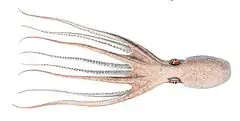Eledone moschata
Eledone moschata, the musky octopus, is a species of octopus belonging to the family Octopodidae.
| Musky octopus | |
|---|---|
 | |
| Museum model of Eledone moschata | |
| Scientific classification | |
| Kingdom: | Animalia |
| Phylum: | Mollusca |
| Class: | Cephalopoda |
| Order: | Octopoda |
| Family: | Eledonidae |
| Genus: | Eledone |
| Species: | E. moschata |
| Binomial name | |
| Eledone moschata | |
| Synonyms [3] | |
| |
Taxonomy
The skin of the single specimen of Eledone microsicya is very similar to the skin of Eledone moschata[4] and some authorities take the view that E. microsicya is not a valid taxon and represents a Red Sea population of the otherwise Mediteraranean E. moschata with which it should synonymised.[5]
Distribution
Eledone moschata is found throughout the Mediterranean Sea, and is occasionally found in adjacent parts of the Atlantic Ocean, around the Gulf of Cadiz and off the coast of Portugal.[6][7][8]
Habitat
The musky octopus occurs on the sandy bottom of the continental platform, at depths up to 400 meters. Usually it lives burrowed into the sediments.[8]
Description
The largest recorded musky octopus was a male with a mantle length of 188 millimetres (7.4 in), a total length of 740 mm (29 in) and a mass of 1,414 grams (3.1 lb), caught in the Gulf of İzmir (Gulf of Smyrna), in the Aegean Sea. This small species has a head smaller than the body, with protruding eyes. The eight tentacles are relatively short and have one row of suckers. The third right arm (called Hectocotylus) is specialized to store and transfer spermatophores to the female. The basic color of the body is gray-brown, with dark, brown to blackish spots.[8]
Eledone moschata is closely related to the horned octopus, Eledone cirrhosa, but can be distinguished by a number of features; for example, E. moschata has smooth skin and smells of musk, while E. cirrhosa has warty skin and no musky odour.[9]
Ecology
E. moschata feeds on a wide variety of crustaceans, molluscs and fish. Crustaceans are preferred, and species known to be eaten by E. moschata include Maja squinado, Maja crispata, Macropodia rostrata, Macropodia longirostris, Pisa tetraodon, Dorippe lanata, Lisa chiragra, Lambrus angulifrons, Lambrus massena, Inachus dorsettensis, Carcinus aestuarii, Pachygrapsus marmoratus, Xantho poressa, Pilumnus hirtellus, Goneplax rhomboides, Pagurus prideauxi, Ilia nucleus and Squilla mantis; molluscs consumed by E., moschata include Clamys varia, Mytilus galloprovincialis, Sepia orbigniyana, Illex coindeti, Loligo subulata; E. moschata also eats the fish Engraulis encrasicolus, Sardina pilchardus, Mullus barbatus, Diplodus annularis, Merluccius merluccius, Merlangius merlangus, Lepidotrigla cavillone, Trachurus trachurus and Trisopterus minutus.[10]
Gallery
 A live individual of Eledone moschata
A live individual of Eledone moschata Illustration
Illustration Illustration (1845)
Illustration (1845) Illustration (1896)
Illustration (1896)
References
- Allcock, L.; Taite, M.; Headlam, J. & Allen, G. (2018). "Eledone moschata". IUCN Red List of Threatened Species. 2018: e.T163360A1001723. doi:10.2305/IUCN.UK.2018-2.RLTS.T163360A1001723.en.
- "Eledone moschata (Lamarck, 1798)". Integrated Taxonomic Information System.
- "Nomenclatural synthesis of Eledone moschata". CLEMAM: Taxonomic Database on European Marine Mollusca. Muséum National d'Histoire Naturelle. Retrieved May 27, 2010.
- Silas E.G. 1968 Cephalopoda of the West Coast of India, collected during the cruise of the research vessel Varuna, with a catalogue of species known from the Indian Ocean, Proc. Symp. Mollusca Part 1, Mar. Biol. Assn India, pp277-259 http://eprints.cmfri.org.in/2365/1/Article_37.pdf
- Register of Marine Species
- Alp Salman; Tuncer Katagan; Ali Cemal Gücü (2000). "The distribution and fishing of two Mediterranean Eledone spp. (Octopoda: Cephalopoda) in the Aegean Sea" (PDF). Turkish Journal of Zoology. 24: 165–171. Archived from the original (PDF) on 2012-02-27.
- WoRMS
- DORIS - Données d'Observations pour la Reconnaissance et l'Identification de la faune et la flore Subaquatiques
- W. J. Rees (1956). "Notes on the European species of Eledone with special reference to eggs and larvae". Bulletin of the British Museum (Natural History) Zoology. 3: 283–293. doi:10.5962/bhl.part.4125.
- Halil Şen Food Preference of Eledone moschata Lamarck, 1799 (Cephalopoda:
Octopodidae) in Captive Conditions International Journal of Natural and Engineering Sciences - volume=1 - pages=29–31
